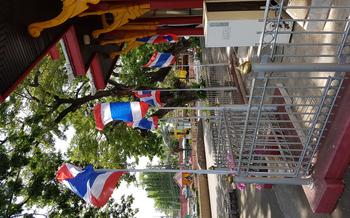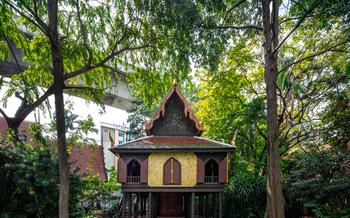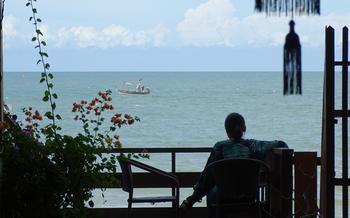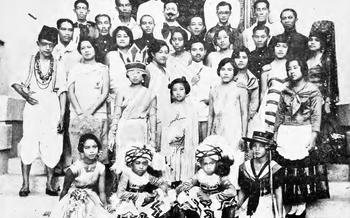
Maruekhathaiyawan Palace (Nearby in Cha am)
- Maruekhathaiyawan Palace: A Historical Gem
- Admission Fees and Opening Hours
- Exploring the Palace Grounds
- Discover the Royal Reception Hall
- Marvel at the Throne Hall
- Uncover the Residential Quarters
- Visit the Museum
- Enjoy a Refreshing Break
- Attend a Traditional Thai Performance
- Explore the Surrounding Area: Unveiling Cha Am's Hidden Gems
- Respect Local Customs and Etiquette
- Plan Your Visit During Festivals
- Insider Tip: Discover Hidden Gems
Maruekhathaiyawan Palace: A Historical Gem
Nestled in the heart of Cha am, Thailand, the Maruekhathaiyawan Palace stands as a testament to the country's rich history and architectural heritage. Built in the early 20th century as a summer retreat for the royal family, this magnificent palace boasts a captivating blend of traditional Thai and European design elements. The palace's strategic location, overlooking the pristine waters of the Gulf of Thailand, further enhances its charm and allure. Today, the Maruekhathaiyawan Palace has become a must-visit destination for travelers seeking a glimpse into Thailand's regal past and architectural splendor.
Admission Fees and Opening Hours
Visiting the Maruekhathaiyawan Palace is a budget-friendly experience, with an entrance fee of only 100 Baht for adults and 50 Baht for children. Additional charges may apply for specific exhibitions or special events held on the grounds. The palace is open to the public daily from 8:30 AM to 4:30 PM, offering ample time to explore the grounds and delve into its rich history.
To avoid queues and ensure a smooth entry, consider purchasing tickets in advance through online platforms or authorized ticket vendors. This will allow you to skip the lines and make the most of your visit.
Photography is permitted within the palace grounds, but visitors are kindly requested to refrain from using flash or tripods to ensure the preservation of the exhibits. By following these guidelines, you can fully immerse yourself in the grandeur of the Maruekhathaiyawan Palace and capture lasting memories of your visit.
Exploring the Palace Grounds
The Maruekhathaiyawan Palace complex encompasses a wealth of structures that mirror the grandeur of the royal family's past. The Royal Reception Hall, with its intricate carvings and elegant furnishings, serves as a testament to the palace's opulence. The Throne Hall, where significant ceremonies took place, exudes an air of majesty with its elaborate throne and ornate decorations. The Residential Quarters, once the private domain of the royal family, offer a glimpse into their personal lives through carefully preserved furnishings and artifacts.
Visitors can wander through the Royal Gardens, a tranquil oasis adorned with vibrant blooms, manicured lawns, and serene ponds. The gardens provide a welcome respite from the grandeur of the palace, inviting visitors to immerse themselves in nature's tranquility. Don't miss the Royal Elephant Stables, where majestic elephants were once kept, adding to the palace's regal aura.
Discover the Royal Reception Hall
The Royal Reception Hall, also known as the "Prasat Pisal Sakorn," is an architectural marvel that stands as a testament to the grandeur of the Maruekhathaiyawan Palace. Characterized by its distinctive octagonal shape and intricate roof design, the hall exudes an aura of elegance and regality.
Upon entering the hall, visitors are greeted by a spacious and well-lit interior, adorned with gleaming chandeliers and opulent furnishings. The walls are adorned with intricate murals depicting scenes from Thai mythology and history, adding a touch of cultural richness to the space.
One of the highlights of the Royal Reception Hall is the intricately carved wooden ceiling, which features a series of panels showcasing various motifs and designs. The craftsmanship and attention to detail are truly remarkable, reflecting the skill and artistry of Thai artisans.
Historically, the Royal Reception Hall was used to host important events and ceremonies, including royal audiences, state banquets, and diplomatic gatherings. It served as a space where the king and queen would receive guests, conduct official business, and celebrate special occasions.
Today, the Royal Reception Hall remains a popular attraction for visitors, inviting them to step back in time and experience the grandeur of the Thai monarchy. Visitors can immerse themselves in the opulent ambiance, admire the exquisite artwork, and learn about the rich history associated with this magnificent hall.
Marvel at the Throne Hall
The Throne Hall, situated at the heart of the Maruekhathaiyawan Palace, stands as a testament to the grandeur and opulence of the Thai monarchy. This majestic hall served as the official venue for royal ceremonies, audiences, and important state functions.
Architectural Highlights: - Admire the intricate details and exquisite craftsmanship of the hall's exterior, showcasing a fusion of traditional Thai and European architectural styles. - Gaze upon the soaring spires, delicate fretwork, and ornate pediments that adorn the façade, reflecting the grandeur of the monarchy. - Step inside to be captivated by the high vaulted ceilings, adorned with intricate murals depicting scenes from Thai mythology and history.
Historical Significance: - The Throne Hall has witnessed numerous significant events throughout Thailand's history, including royal coronations, state banquets, and the signing of important treaties. - It served as the venue for the proclamation of the end of absolute monarchy and the adoption of the country's first constitution in 1932, marking a pivotal moment in Thailand's political evolution.
Ceremonies and Events: - While the Throne Hall is no longer used for official ceremonies, it occasionally hosts special events, such as exhibitions or cultural performances, offering visitors a glimpse into the rich history and traditions of the Thai monarchy. - Visitors can immerse themselves in the grandeur of the hall by attending these events, gaining a deeper understanding of Thai culture and its deep-rooted reverence for the monarchy.
Uncover the Residential Quarters
Beyond the formal halls and public spaces, the Maruekhathaiyawan Palace offers a glimpse into the private living quarters of the royal family. These secluded chambers, once reserved for the king, queen, and their entourage, provide a unique perspective on their daily life and personal interests.
The residential quarters are a testament to the royal family's refined taste and appreciation for comfort. The rooms are adorned with elegant furnishings, intricate carvings, and artwork that reflect their status and cultural heritage. Visitors can admire the opulent bedrooms, private sitting rooms, and dining areas, each designed to provide a sense of privacy and tranquility.
Historical anecdotes and stories add to the allure of the residential quarters. Guides or informative plaques often share tales of royal traditions, family gatherings, and personal moments that took place within these walls. These stories help visitors connect with the human side of the royal family and gain a deeper understanding of their lifestyle and customs.
Exploring the residential quarters is like stepping into a time capsule, where the past and present intertwine. Visitors can imagine the royal family's daily routines, their interactions with each other, and the decisions that shaped the course of Thailand's history. It's an intimate glimpse into a world that is both fascinating and awe-inspiring.
Visit the Museum
Step into the Maruekhathaiyawan Palace Museum to delve into the rich history and cultural heritage of Thailand. Adorned with intricate carvings and elegant architecture, the museum houses a treasure trove of artifacts, documents, and exhibits that narrate the captivating story of the palace and its royal inhabitants.
Discover ancient relics, royal regalia, and personal belongings that once graced the lives of the Thai monarchy. Immerse yourself in the fascinating tales of the palace's construction, its significance as a royal retreat, and the events that unfolded within its walls. Learn about the traditions, customs, and ceremonies that shaped the lives of the royal family and left an indelible mark on Thai history.
The museum serves as a window into the past, providing visitors with a deeper understanding of Thailand's royal lineage, its cultural traditions, and the enduring legacy of the Maruekhathaiyawan Palace. Through interactive displays, multimedia presentations, and informative exhibits, the museum invites visitors to embark on a journey through time and gain a profound appreciation for the kingdom's rich heritage.
Enjoy a Refreshing Break
After exploring the Maruekhathaiyawan Palace's rich history and architecture, take a break and indulge in a delightful culinary experience. Within the palace grounds, you'll find a charming café that offers a variety of refreshments to quench your thirst and satisfy your taste buds.
Savor the flavors of traditional Thai cuisine as you relax in a serene setting. The café's menu features a selection of authentic Thai dishes, including fragrant curries, spicy salads, and delectable desserts. Enjoy the culinary delights while soaking in the tranquil atmosphere of the palace gardens.
For those seeking a caffeine fix, the café also offers a variety of aromatic coffees and teas. Sip on a refreshing iced coffee as you admire the stunning views of the palace grounds.
Whether you're looking for a quick snack or a leisurely lunch, the café at Maruekhathaiyawan Palace provides the perfect respite to revitalize and continue your exploration of this historical gem.
Attend a Traditional Thai Performance
Immerse yourself in the vibrant tapestry of Thai culture by attending a traditional Thai performance at the Maruekhathaiyawan Palace. These captivating shows offer a glimpse into the kingdom's rich artistic heritage, showcasing the grace, skill, and storytelling prowess of Thailand's talented performers.
Witness the mesmerizing movements and intricate costumes of classical Thai dance, as dancers bring ancient legends and folklore to life. Be enthralled by the rhythmic beats of traditional Thai music, played on instruments like the khene, ranat ek, and ching. Experience the humor and satire of Khon masked dance, a unique form of Thai theater that combines elaborate masks, elaborate costumes, and dynamic movements.
These performances not only entertain but also provide a deeper understanding of Thai history, customs, and beliefs. They are a testament to the enduring power of Thai culture and its ability to captivate audiences of all ages.
To ensure a memorable experience, book your tickets in advance, especially if you're visiting during peak season. Check the palace's official website or contact the tourist information center for performance schedules and ticket prices. Whether you're a seasoned traveler or a first-time visitor to Thailand, attending a traditional Thai performance at the Maruekhathaiyawan Palace is an experience not to be missed.
Explore the Surrounding Area: Unveiling Cha Am's Hidden Gems
While visiting the Maruekhathaiyawan Palace, don't miss the opportunity to explore the vibrant town of Cha am and its surrounding attractions. Just a short distance away, you'll find pristine beaches, serene temples, and bustling local markets.
For a relaxing beach day, head to Cha Am Beach, known for its soft white sand and crystal-clear waters. Enjoy swimming, sunbathing, or indulging in water sports like jet-skiing and banana boat rides.
To delve into Thai culture and history, visit the Cha Am Forest Park, home to the iconic Khao Nang Phanthurat, a limestone mountain featuring a series of caves with ancient Buddha images. Explore the park's lush trails, encounter wildlife, and discover hidden viewpoints offering breathtaking panoramas.
If you're a food enthusiast, explore the local markets of Cha am, where you'll find an array of fresh seafood, tropical fruits, and traditional Thai delicacies. Indulge in the flavors of local street food or savor a delicious meal at one of the many restaurants in town.
To make the most of your time in Cha am, create a well-rounded itinerary that balances historical exploration with nature and cultural experiences. Plan your visit to coincide with local festivals or events for an immersive cultural experience.
Respect Local Customs and Etiquette
When visiting the Maruekhathaiyawan Palace, it is essential to be mindful of local customs and etiquette to show respect for Thai culture and traditions. Visitors should dress appropriately, avoiding shorts, tank tops, or revealing clothing. Modest attire that covers shoulders and knees is recommended. When entering the palace, it is customary to remove shoes and place them in the designated racks. Visitors should also be mindful of their behavior, speaking softly and avoiding loud noises or disruptive actions. Photography is permitted within the palace grounds, but it is important to refrain from using flash or taking photos of the royal family or any sensitive areas.
- Dress Code: Respect the local culture by dressing modestly, covering your shoulders and knees.
- Shoe Removal: Remove your shoes before entering the palace and place them in the designated racks.
- Quiet Behavior: Be mindful of your noise level, speaking softly and avoiding disruptive actions.
- Photography Etiquette: Take photos without using flash and avoid capturing the royal family or sensitive areas.
Plan Your Visit During Festivals
The Maruekhathaiyawan Palace comes alive during festivals and special events, offering visitors a chance to witness the vibrant Thai culture firsthand. Every year, the palace hosts the Chulachomklao Day, a grand celebration honoring the founder of the palace and the Chakri dynasty. The event features colorful processions, traditional performances, and cultural exhibitions, providing a glimpse into Thailand's rich history and heritage.
Another must-see festival is Loy Krathong, the Festival of Lights, when thousands of people gather at the palace to release floating lanterns into the sky. This magical event creates a breathtaking spectacle as the lanterns illuminate the night sky, symbolizing good luck and prosperity.
If you're fortunate enough to visit during these festivals, be prepared for a truly immersive and unforgettable experience. Embrace the festive spirit, join the locals in their celebrations, and discover the essence of Thai culture at its finest.
Insider Tip: Discover Hidden Gems
Beyond the main attractions, the Maruekhathaiyawan Palace holds hidden gems waiting to be discovered. One such gem is the secluded garden nestled behind the Throne Hall. This tranquil oasis offers a serene escape from the bustling palace grounds, where visitors can find solace amidst lush greenery and vibrant blooms. Take a leisurely stroll along the winding paths, admire the intricate landscaping, and find a secluded spot to soak in the tranquility of this hidden paradise.
Another hidden gem is the small museum located within the palace grounds. This unassuming museum houses a collection of artifacts and exhibits that provide a glimpse into the history and culture of Thailand. From ancient pottery and textiles to royal regalia and weaponry, the museum offers a fascinating journey through time. Spend some time exploring the exhibits and gaining a deeper understanding of the rich heritage of this remarkable country.
For those seeking a unique perspective of the palace, consider visiting during the early morning hours or just before sunset. The soft golden light casts a magical glow on the palace grounds, creating a picturesque scene that is perfect for capturing stunning photographs. Take advantage of the tranquility of these quiet hours to explore the palace at your own pace and soak in its beauty without the crowds.





